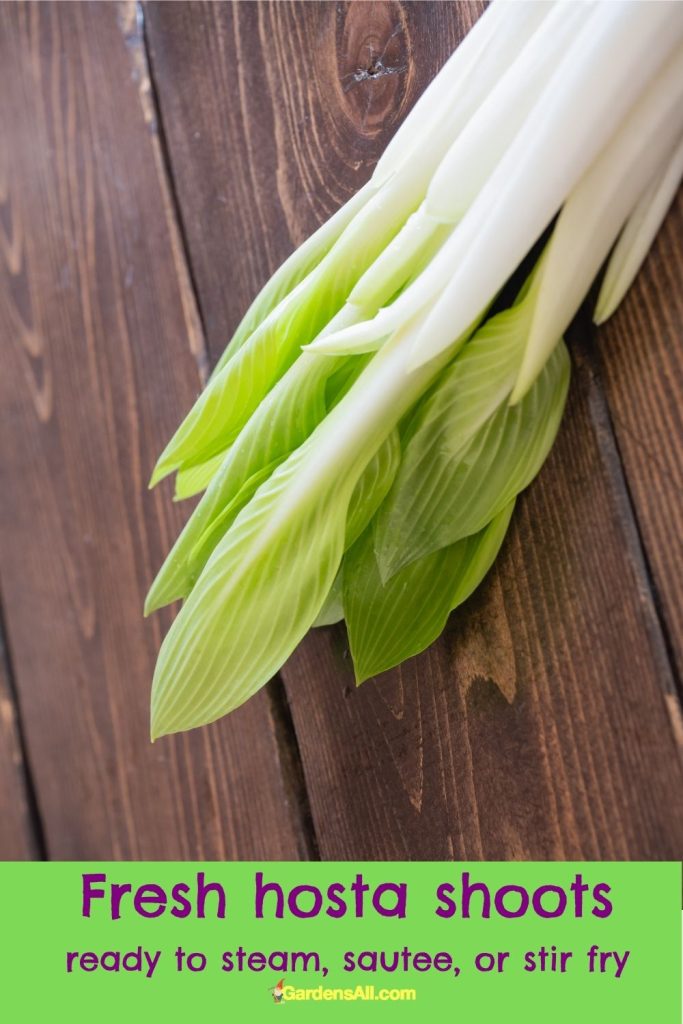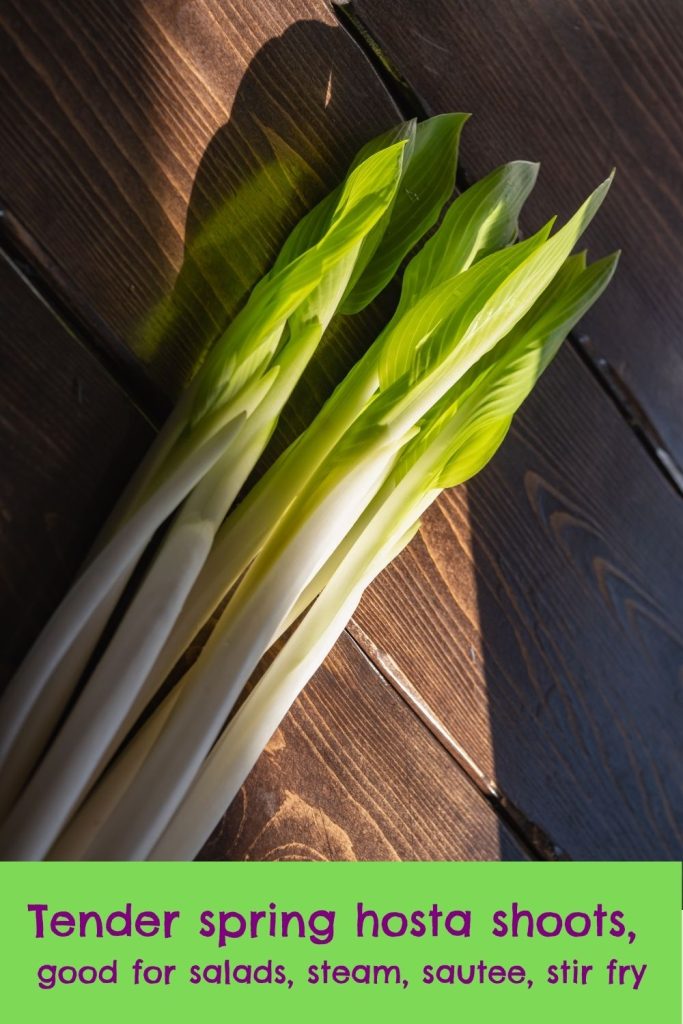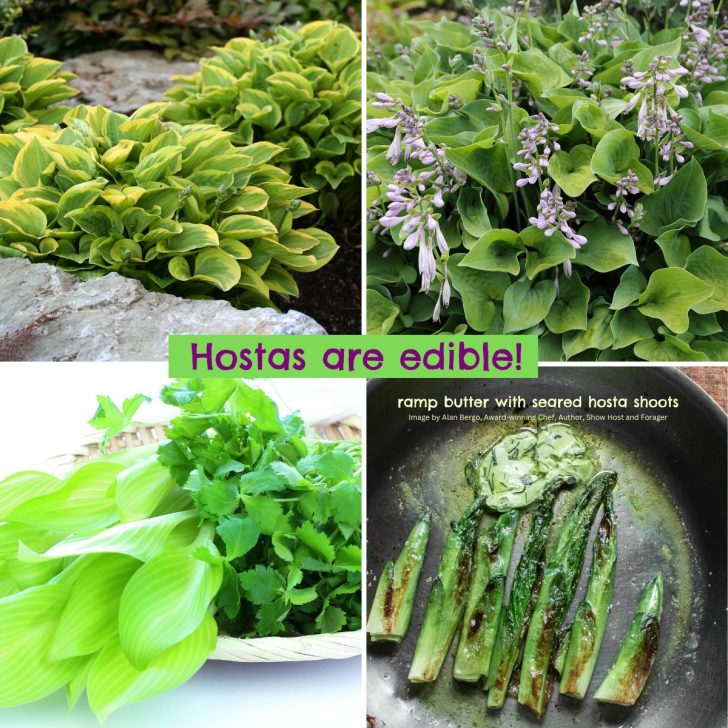It’s well known that deer eat hostas (unfortunately). But are hostas edible for people?
Yes! You can eat hostas, and while wildlife may eat them, it’s not good for pets. (See plants poisonous to dogs).
We don’t usually eat hostas because we don’t have lots and prefer to enjoy them in the landscape. However, we noticed several hosta volunteers growing in odd places, so those we harvest to eat.
In the West, we primarily think of hostas as ornamental landscape plants, however, their edible origins trace back for centuries in Asian countries.
If Hostas Are Edible, What Parts of Hosta Plants Can You Eat?
You Can Eat Hosta Leaves
Consider that you can eat hosta leaves in much the way you would prepare and consume other thicker, cookable greens like kale, chard and spinach. That means they can be cooked as potherbs in soups, stir fry, steamed and chopped or shredded and eaten raw in salads.
Some use hosta leaves as wraps, similar to cabbage leaves or grape leaves. Naturally, as with all greens, the younger leaves are more tender.
Here’s an example of hosta leaves wrapped in bacon.

However, the favorite way to consume hosta greens is as young spear-like shoots.

Edible Hosta Shoots
The young hosta shoots are favored for the best culinary experience. The’re tender and delicious, reminiscent of a cross between asparagus and fern fiddleheads. So you can prepare hosta shoots in exactly the same way you enjoy either of these vegetable delicacies.
Pictured below (top right) are hosta shoots seared in homemade ramps butter, which is a perfect complementary garlic flavored spring companion vegetable. We would also just sauté these in butter or olive oil along with the full ramps vegetable.

You can find the hosta recipe for award winning chef, Alan Bergo’s, delicious seared hosta shoots with wild ramps butter recipe.
Are Hosta Flowers Edible?
Just like the hosta leaves, hosta flowers are also edible. Reportedly, they don’t add remarkable flavor, but as with other edible flowers, they do add an exotic aesthetic to any dish. Use as a garnish to a well plated meal or as a topping for a salad.

An Early Spring Harvest Dish
Consider sauteeing hosta shoots in olive oil or butter along with ramps vegetables and mushrooms for a mouthwatering side dish served over wild rice for dinner or with eggs or an omelette for breakfast.

It’s Okay to Harvest Hosta Shoots
When it comes to harvesting delicacies like edible flowers, fern heads, and hosta shoots, we always hesitate, because we love to see the plants grow into all that they can be. However, if you have plenty of space to grow extra, then you’ll have the best of both worlds: hostas to grace your landscape and your plate!
Oh… and if you live in an area that’s controlled by a homeowners association with HOA gardening rules that don’t allow gardening, hostas are a perfect example of edible ornamental landscaping plant for foodscaping!
There are many beautiful landscape hostas to grow, from the captivating variegated varieties to the elegant blue hostas, they all add presence and beauty to landscaped areas.
Which Hostas Are Edible?
All hostas are edible, so you can give a few shoots of yours a try. However, those favored for the best flavor are the Hosta montana, formerly named H. fortunei var gigantea.[1]http://www.plantsgalore.com/hostas/cultivars/species/Hosta_montana.htm[2]https://www.hostalibrary.org/species/pdf/montana2.pdf
Hosta montana Varieties
- H. montana – the “typical” green-leaved species
- H. montana ‘Aureomarginata‘- Yellow margined
- H. montana ‘Mountain Snow’– White margined
- H. montana ‘Choko Nishiki’– Gold centered
- H. montana ‘Emma Foster’– Gold leaf
- H. montana macrophylla – large green leaves
All hostas are edible, however, those favored for the best flavor are the Hosta montana.
Hosta Scientific Name
The botanical name for the hosta plant is Hosta plantaginea, of the family, Asparagaceae. So — as you may have guessed — hostas are in the asparagus family, which should give you a clue as to how you might enjoy eating hostas.
While the hosta spears resemble asparagus, they’re actually shoots that unfurl as leaves.

Common Names for Hostas
- Ōba Gibōshi (Japanese)
- Hosta
- Plantain Lily
Some Edible Asparagaceae Family Members
Not all plants in the Asparagaceae family are edible, however here’s a partial list, but do your homework and research if and how to consume.
- Agave tequilana
- Asparagus, Asparagaceae
- Camas bulbs, Camassia[3]https://willamettebotany.org/asparagaceae/
- Hostas, Hosta (see blue hostas)
- Hyacinths –
- Desert Hyacinth, Dichelostemma
- Grape Hyacinth, Muscari
- Solomon’s seal, Polygonatum
- Snake plants, Sansevieria
- Triplet Lilies, Triteleia grandiflora
- Tuberose (Polianthes tuberosa)
- Wild Hyacinth, Brodiaea[4]https://willamettebotany.org/asparagaceae/
- Yucca, Yucca
REFERENCES: Willamettebotany, Encyclopedia Britannica
So… Are Hostas Edible?
Yes they are, but words of warning, (in case you haven’t yet experienced it): deer are known to devour hostas. So if you’re going to grow more, you might need some deer deterrents, if you have them in your area.

I’m LeAura Alderson, a garden, herb and plant enthusiast with a passion for discovering the many edible and medicinal benefits of the plants all around us, including the weeds! I’m a writer, editor and media publisher for our family of websites.
While I was certified in fitness and life coaching, I am NOT a health practitioner. However, I’m a lifelong health enthusiast, with a keen interest in healthy, organic foods and making home remedies and the content we share is from our own experience and usage as well as that extracted from scientific research so that you can explore further on your own.
Always seek the advice and guidance of your health practitioners first and foremost.
As a family we’re steadily expanding our gardening, experimentation and knowledge around all things gardening, edible landscaping, fresh organic foods and self sustainability with farming in our future. I also own and manage iCreateDaily.com, a site all about transformation through creation, and the power of positivity, optimism and mindset.
References

